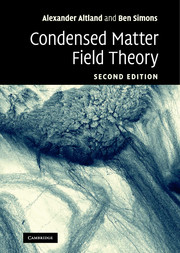Book contents
- Frontmatter
- Contents
- Preface
- 1 From particles to fields
- 2 Second quantization
- 3 Feynman path integral
- 4 Functional field integral
- 5 Perturbation theory
- 6 Broken symmetry and collective phenomena
- 7 Response functions
- 8 The renormalization group
- 9 Topology
- 10 Nonequilibrium (classical)
- 11 Nonequilibrium (quantum)
- Index
2 - Second quantization
Published online by Cambridge University Press: 04 August 2010
- Frontmatter
- Contents
- Preface
- 1 From particles to fields
- 2 Second quantization
- 3 Feynman path integral
- 4 Functional field integral
- 5 Perturbation theory
- 6 Broken symmetry and collective phenomena
- 7 Response functions
- 8 The renormalization group
- 9 Topology
- 10 Nonequilibrium (classical)
- 11 Nonequilibrium (quantum)
- Index
Summary
The purpose of this chapter is to introduce and apply the method of second quantization, a technique that underpins the formulation of quantum many-particle theories. The first part of the chapter focuses on methodology and notation, while the remainder is devoted to the development of applications designed to engender familiarity with and fluency in the technique. Specifically, we will investigate the physics of the interacting electron gas, charge density wave propagation in one-dimensional quantum wires, and spin waves in a quantum Heisenberg (anti) ferromagnet. Indeed, many of these examples and their descendants will reappear as applications in our discussion of methods of quantum field theory in subsequent chapters.
In the previous chapter we encountered two field theories that could conveniently be represented in the language of “second quantization,” i.e. a formulation based on the algebra of certain ladder operators âk. There were two remarkable facts about this formulation: firstly, second quantization provides a compact way of representing the many-body space of excitations; secondly, the properties of the ladder operators were encoded in a simple set of commutation relations (cf. Eq. (1.33)) rather than in some explicit Hilbert space representation.
Apart from a certain aesthetic appeal, these observations would not be of much relevance if it were not for the fact that the formulation can be generalized to a comprehensive and highly efficient formulation of many-body quantum mechanics in general.
- Type
- Chapter
- Information
- Condensed Matter Field Theory , pp. 39 - 94Publisher: Cambridge University PressPrint publication year: 2010
- 2
- Cited by

